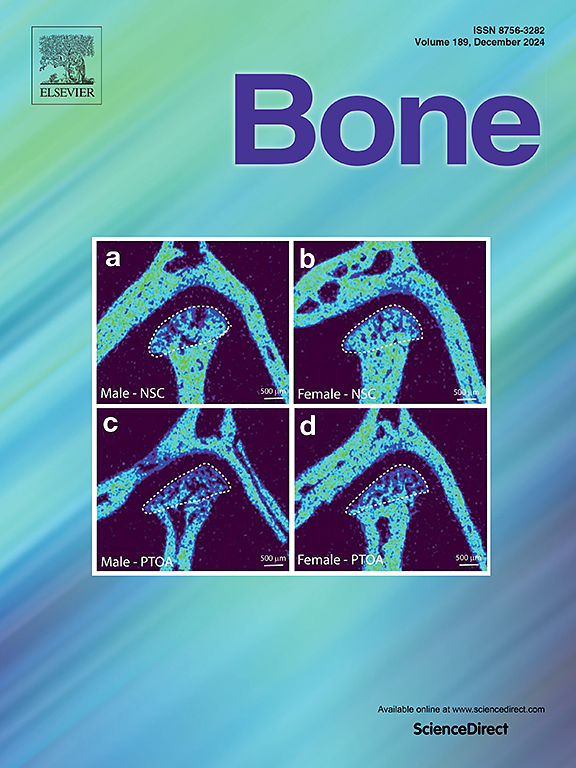前列腺癌患者接受雄激素剥夺疗法后脊椎生物力学特性的改变。
IF 3.6
2区 医学
Q2 ENDOCRINOLOGY & METABOLISM
引用次数: 0
摘要
已知雄激素剥夺疗法(ADT)用于局部和转移性前列腺癌(PCa)可以提高患者的生存率,但对骨骼有负面的长期影响,包括降低骨密度(BMD)和增加骨折风险。以前,双能x射线吸收仪(DXA)测量椎骨的面积骨密度(aBMD)。然而,椎体骨强度的预测需要aBMD无法提供的信息,如几何和体积骨密度(vBMD)。本研究旨在通过DXA、定量计算机断层扫描(QCT)和有限元(FE)模型的结合,研究ADT对椎骨密度(aBMD、小梁vBMD、整体vBMD)和机械完整性(破坏载荷和破坏强度)的影响。对于FE建模,从26例ADT治疗患者的QCT图像重建3D模型,以及他们的匹配对照,收集作为羚羊临床试验的一部分。ADT治疗组小梁和整体vBMD显著降低(小梁vBMD: -18 %,p本文章由计算机程序翻译,如有差异,请以英文原文为准。
Altered vertebral biomechanical properties in prostate cancer patients following androgen deprivation therapy
Androgen deprivation therapy (ADT) for localised and metastatic prostate cancer (PCa) is known to improve survival in patients but has been associated with negative long-term impacts on the skeleton, including decreased bone mineral density (BMD) and increased fracture risk. Generally, dual-enery X-ray absorptiometry (DXA) measurements of areal BMD (aBMD) of vertebrae are used clinically to assess bone health. However, a prediction of vertebral bone strength requires information that aBMD cannot provide, such as geometry and volumetric BMD (vBMD). This study aims to investigate the effect of ADT on the densitometric (aBMD, trabecular vBMD, integral vBMD) and mechanical integrity (failure load and failure strength) of vertebrae, using a combination of DXA, quantitative computed tomography (QCT) and finite element (FE) modelling. For the FE analyses, 3D models were reconstructed from QCT images of 26 ADT treated patients, and their matched controls, collected as part of the ANTELOPE clinical trial. The ADT treated group experienced significantly decreased trabecular and integral vBMD (trabecular vBMD: −18 %, p < 0.001, integral vBMD: −11 %, p < 0.001) compared to control patients that showed no significant temporal changes (trabecular vBMD p = 0.037, integral vBMD p = 0.56). A similar trend was seen in the ADT treated group for the failure load and failure strength, where a decrease of 14 % was observed (p < 0.001). When comparing the proficiency in predicting the mechanical properties from densitometric properties, the integral vBMD performed best in the pooled data (r = 0.86–0.87, p < 0.001) closely followed by trabecular vBMD (r = 0.73–0.75, p < 0.001) with aBMD having a much weaker predictive ability (r = 0.19–0.21, p < 0.01). In conclusion, ADT significantly reduced both the densitometric properties and the mechanical strength of vertebrae. A stronger relationship between both trabecular vBMD and integral vBMD with the mechanical properties than the aBMD was observed, suggesting that such clinical measurements could improve predictions of fracture risk in prostate cancer patients treated with ADT.
求助全文
通过发布文献求助,成功后即可免费获取论文全文。
去求助
来源期刊

Bone
医学-内分泌学与代谢
CiteScore
8.90
自引率
4.90%
发文量
264
审稿时长
30 days
期刊介绍:
BONE is an interdisciplinary forum for the rapid publication of original articles and reviews on basic, translational, and clinical aspects of bone and mineral metabolism. The Journal also encourages submissions related to interactions of bone with other organ systems, including cartilage, endocrine, muscle, fat, neural, vascular, gastrointestinal, hematopoietic, and immune systems. Particular attention is placed on the application of experimental studies to clinical practice.
 求助内容:
求助内容: 应助结果提醒方式:
应助结果提醒方式:


